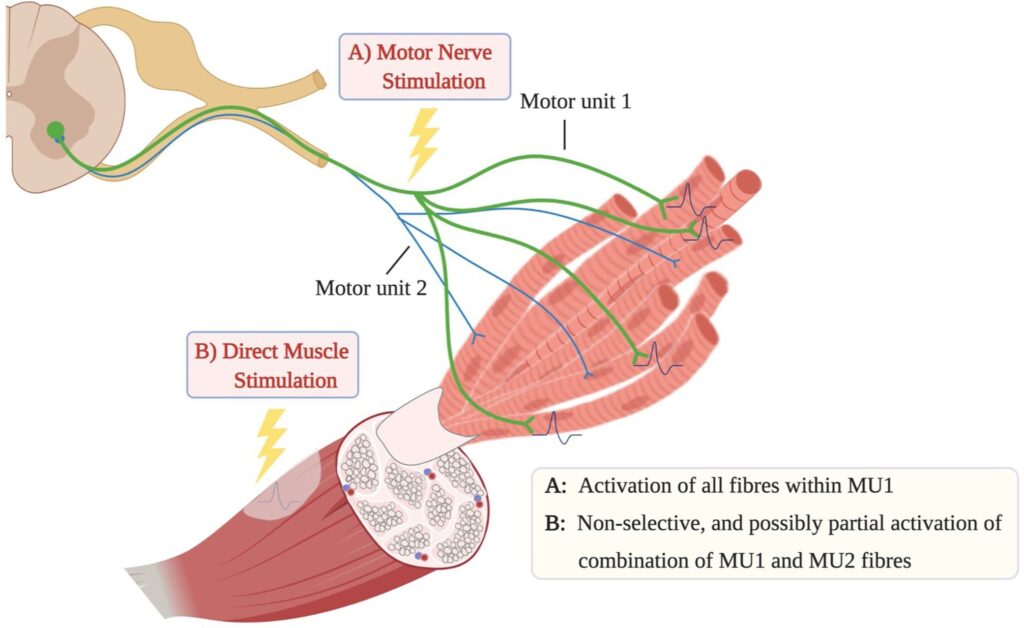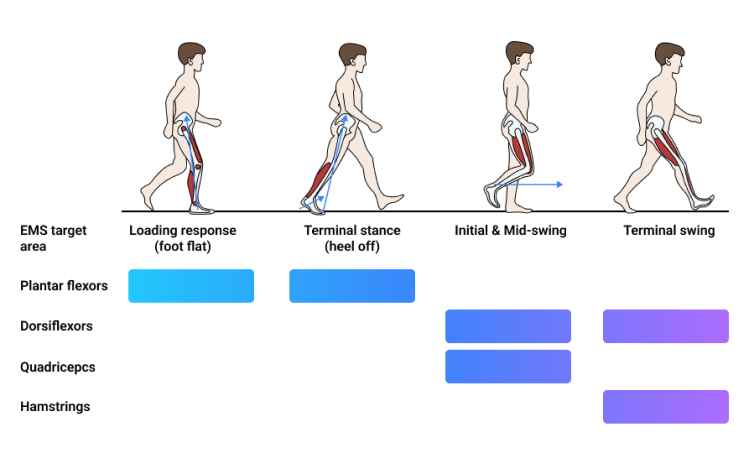Haptic feedback powered by electrical muscle stimulation has given rise to an extraordinary advancement known as Functional Electrical Stimulation (FES), which has improved the healthcare industry. In this blog post, we’ll be sharing what FES is all about, how it works and the benefits it brings to clinical practice.
Introduction
So what is FES? Functional Electrical Stimulation, or FES, is the use of electrical stimulation to activate multiple muscles in a specific sequence. This technique is typically used to help people with spinal cord injuries or sports injuries. The development of FES can be traced back to the 20th century, when major discoveries were made in the fields of medicine and electrical engineering. The idea of using electrical stimulation to restore muscle function was popularised by Dr Liberson in the 1960s. At the time, he called it functional electrotherapy. However, it was not until 1967 that the term functional electrical stimulation was patented and later used in clinical practice.
How does it work
Let’s look at the science behind Functional Electrical Stimulation to find out how it works. Think of it like this: electrodes on your skin send signals to your nerves, resulting in muscle contractions that mimic natural movements (Figure 1).

FES can customise the stimulation parameters, making it easier to adapt to the individual’s needs. This allows people with impaired muscle function, such as those with spinal cord injuries or neurological disorders, to regain mobility and improve their functional abilities.
Main groups of FES devices
Functional electrical stimulation devices are widely applied in rehabilitation and medical practice. The underlying technique uses low-energy electrical pulses to artificially generate body movements in individuals after various medical conditions including stroke, spinal cord injury, multiple sclerosis, cerebral palsy, etc.
Open-loop FES Devices
Open-loop functional electrical stimulation devices use pre-programmed stimulation patterns without real-time feedback. First and foremost, these devices have pre-defined stimulation parameters, such as intensity, duration and frequency of electrical impulses. Whilst they still get the job done, they lack real-time feedback and have limited adaptability. The absence of real-time feedback and limited adaptability restricts the ability to respond dynamically to changes in muscle response and to differentiate stimulation parameters during a session.
Closed-loop FES Devices
Closed-loop FES devices can continuously monitor the user’s physiological signals or external sensory input to gather real-time information about muscle activity, joint position, force exertion or other relevant parameters and provide real-time feedback. Based on the real-time feedback received, closed-loop FES devices can adjust the intensity, timing, duration or pattern of electrical stimulation. This adaptability allows precise stimulation to be delivered to meet the user’s needs and optimise functional outcomes. Closed-loop devices enhance control and safety with their ability to adapt and personalise to specific movement patterns or changing requirements.
TESLASUIT as a finite-state device
The exploratory study conducted by the TESLASUIT team discovered the capabilities of the full-body wearable TESLASUIT to be used as both an open-loop and closed-loop FES device. Furthermore, in the TESLASUIT use case you can discover how the suit is used for finite state FES. Finite state FES helps to correct dropped foot, a term used to describe difficulty in lifting the front of the foot. A step detector was used to provide information about foot-ground contact for each foot separately. And so, using data from the step detector, simplified electrical stimulation patterns have been assigned to lift the foot and the muscles that turn the foot out, helping to create a natural walking pattern.

What TESLASUIT and FES bring to the table
The electrical stimulation provided by the TESLASUIT makes it a very suitable full-body FES device for rehabilitation. The fusion of haptic feedback and electrical stimulation creates an immersive and personalised rehabilitation experience, empowering patients to actively engage in their therapy sessions. With real-time feedback and customisable settings, the TESLASUIT can help healthcare professionals tailor treatment plans to individual needs and progress.
In addition, the use of the TESLASUIT and the VR environment can bring elements of gamification to rehabilitation. Patients can feel virtual environments and receive tactile cues, making therapy sessions more engaging and enjoyable. This gamified approach motivates individuals to actively participate and stay engaged in their recovery journey.
Conclusion
To sum up, FES (Functional Electrical Stimulation) is a great technique that uses electrical stimulation to activate muscles. As a device, FES can easily be used in a clinical setting with patients who have spinal cord injuries or sports injuries. It can also be beneficial for gait training, with the ability to monitor the accuracy of joint angles while walking, helping the patient to get into the correct walking position.
By seamlessly combining haptic feedback and functional electrical stimulation, the TESLASUIT offers an immersive and personalised therapeutic experience unlike any other. As the bond between the TESLASUIT and FES grows stronger, a new era of rehabilitation is dawning, bringing changes to the life of people on the road to recovery.
Similar article: Capabilities of full-body wearable Teslasuit as a self-standing FES device
